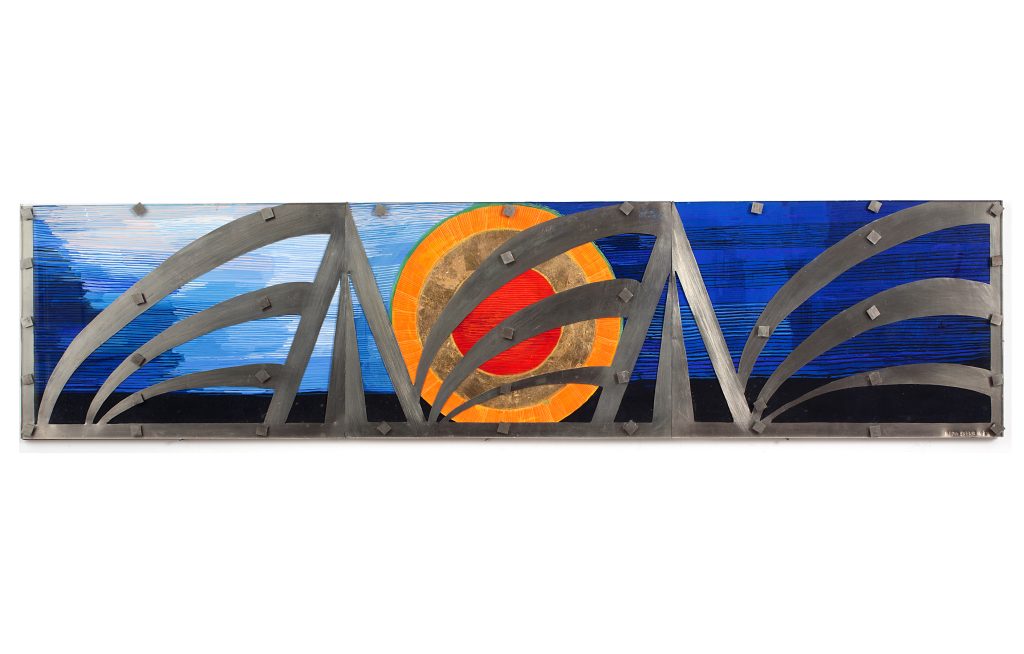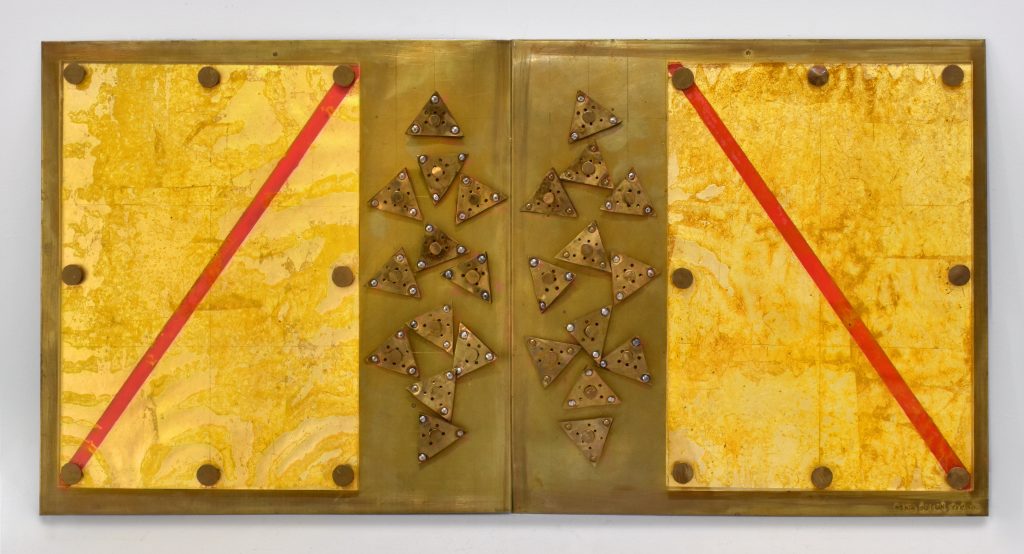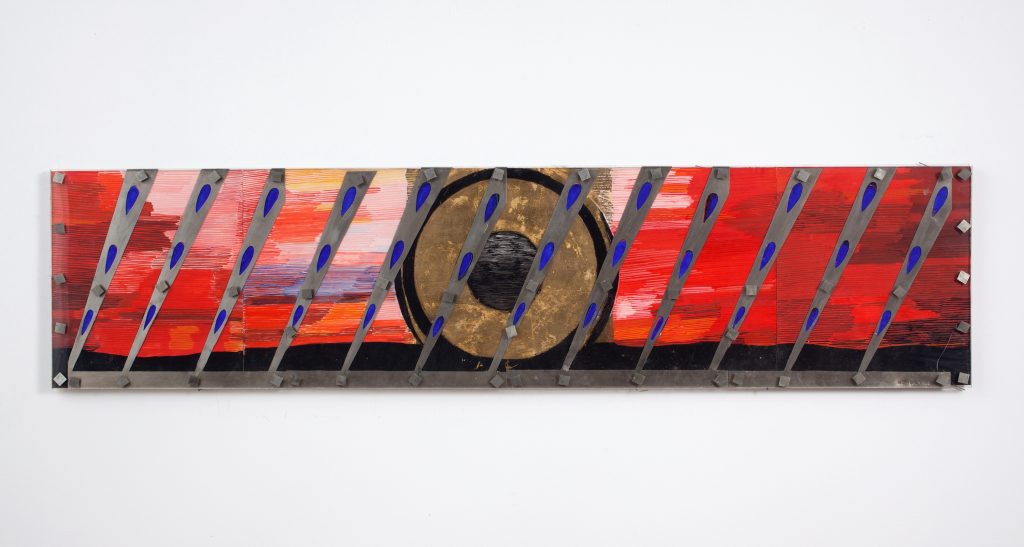Uniquely fashioned works by the late artist Resia Schor on display as part of “War and Peace” at New York City’s Satchel Projects point to our inner emotional worlds intermingling with modern environments of industry and architecture, and Schor’s vision for this relationship is resolute and, honestly, moving.
Her works convey, in some areas, visual stability to a point that feels positively relentless. The rhythms and impressions left are emphatic and given ample space to ring out and linger, visually evoking something like echoing music in a sweeping concert/performance hall in which merely being present makes one a witness to gravitas that’ll stick with you.
How these Artworks were Created
The wall-hanging pieces are layered. “Red Sun” (1987), for example, features gouache on paper, gold leaf, white metal, and Plexiglas, and the layering of these components both here and elsewhere brings everything further into the viewer’s space than you might expect.
“Red Sun” in particular presents (in the layer that’s gouache on paper) a spherical, celestial body with a bright-red center on a surreal backdrop that evokes a landscape that’s not quite parallel to what’s perhaps most familiar from the natural environment. Some of the tones of the varying blue that fills out the sky-evoking areas in this set-up feel nearly palpable, building into such richness that the colors themselves seem to be granted a physical presence.
Atop that paper sits the white metal, arranged in formations that seem to evoke plant life. It looks like we’re viewing the top parts of rather large specimens that you’d imagine fight back against the hypothetical wind as much as they’re directly affected by it. It’s a series of blade-like shapes that seem built like large leaves on several stalks.
Apart from any real-world analogue for the forms, the impact is startling.
Foundationally, Schor used similar combinations of materials in much of the work that’s part of “War and Peace,” and the unique feel of putting these things together is a leading element in how the finished pieces are experienced. The juxtaposition of flowing gouache on paper and perhaps chilly metal comes across as enveloping and organic, specifically in the way that such a thing can draw you in.
In context, it’s not really jarring to move from the painted environments to the metal, instead seeming, as a baseline, even welcoming! These materials’ interactions hover around two poles. The gouache and “softer” elements moderate the metal as much as the reverse is true, and in those even-keeled, forward-looking relationships themselves is laid a foundation where things start getting elevating.
Evoking an Expansive World
The actual forms across “Red Sun” — and other pieces, like “Heartbreak” (1979), which features a visually dramatic series of smaller, triangular shapes — start growing the impact. Proportionally (in terms of the overall shape of the piece), the sun and curved, blade-like forms across the first of those are very large, moving collectively all the way up to the edge. Like the feel of combining the gouache with metal, each component feels utterly emphatic — and in sharper relief.
If you imagine yourself in an actual landscape as the perspective of this, the sun looks like it’ll reach the edges of your field of vision, and the shapes of the white metal jump emphatically into something sharper but also sweeping and grandiose. It’s an inviting scene, one that could feel even homely, but it’s awe-inspiring, really. It’s a stirring reflection of the beauty and foreboding inherent sometimes in looking upon the actual sun.

“The Black Sun of Melancholy” (1988) is similar in shape to “Red Sun,” both of which are rather large rectangles. Here, the color of the evident sky has changed into a palette of ensnaring heat (it’s a lot of red), and the metal, in diagonal strips, is now used to frame what seem like rain drops. And the sun, of course, now has a black center.
The shifts increase the feeling of expansiveness in this imagined landscape, as red — and there’s really a lot of it here — seems to carry such a feeling of physical impact. The diagonal metal that is layered on top of the gouache on paper that’s part of this similarly layered piece also allows, because it’s a series of separated but still sharp forms, for serious intensity to build. It all hearkens with remarkable clarity to the awesome power of the natural world.
Inner Workings of Our Environments
I grew up somewhere often impacted by hurricanes, and Schor is artistically keying into something that I think is important about that realm of real-world occurrence. These massive, sweeping forces that move across the face of the earth are, in some (of course not-quite-literal) way, alive. They’re huge and beyond us… but they’re still, in some ways, part of us. Often, it’s about learning to live with that kind of thing more than wishing it away, and indeed, there’s still a personal touch to this “Black Sun,” in which many of the same forces are present that I’ve been writing about.
And now for one that’s just really cool. “Storm on the Cape” (1985) layers, like before, gouache on paper with white metal and Plexiglas, and the paper part of this one really captured my attention. Using a wide-ranging but easily natural world-evoking variety of color, Schor put the gouache down with a flurry of curved hatching: line atop line atop line, and so on. The pieces of line that comprise the broader piece are quite small, and in the rounds of repetition, there’s a tension that really is evocative of a real-world storm. And the metal atop that background reminds me of a lightning strike, formed in its overall outline from a jagged series of diagonals.
Schor, who was born in Poland, worked in areas separate from this but still related to it, also crafting jewelry and Judaica. (A snapshot of her work in the latter was part of this exhibition.) She found a vision that sometimes turned dramatic but in any context was relentlessly moving, offering a chance to build something sweeping and even heavenly from the sometimes violent clash in our times of humankind and its menagerie of machinery.
“Resia Schor: War and Peace” is on view at Satchel Projects in Chelsea through May 11.
Featured image: Resia Schor, “Heartbreak” (1979). Brass, gouache and gold leaf on paper, Plexiglas. Image courtesy of Satchel Projects



You may also like
-
Diana Kurz at Lincoln Glenn in New York: A Review of a Shining Art Exhibition
-
Dustin Hodges at 15 Orient in New York City: An Ensnaring Exhibition at an Exciting Gallery
-
Maren Hassinger at Susan Inglett Gallery in New York: Reviewing an Uplifting Art Exhibition
-
Enzo Shalom at Bortolami in New York City: Reviewing an Entrancing Exhibition of Paintings
-
“Ben Werther: Townworld” at Amanita in New York City: Reviewing a Richly Memorable Art Exhibition